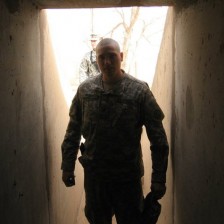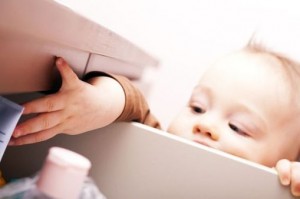I became aware of an interesting situation the other day. Both my girls were pretty good about staying out of cupboards when they were toddlers, but as my son starts hitting the toddler stage and getting more mobile I can see some potential issues arising and a necessity to do a little better childproofing.
My mother shared these two true stories with me.
“Jacob was about 10 months old. He was crawling, but not walking yet. He and his mother and brothers were visiting their grandma. The other boys came to mom and said: Hey mom, Jacob sure looks funny. Mom went to check it out and Jacob was all white in his face. Grandma had her laundry detergent standing on the floor of the laundry room and Jacob had gotten into it. Mom knew it had burn potential, so she immediately washed it out of his eyes. Then she noticed he wasn’t breathing. When she opened his mouth, it was full of laundry soap. She emptied his mouth and rinsed it out. He still wasn’t breathing and mom realized he had gotten it down into his throat. When laundry detergent or dish washer detergent gets wet, it expands, and that is what it had done in Jacob’s throat, creating a snug cork. The hospital was 40 minutes away in Price. It would be faster to just go there, so grandma went to fetch her keys. But mom knew she had to get air into Jacob before then. She stuck her two fingers down his throat as far as she could – until his teeth took the skin off her hand above the top knuckles. She dug out what she could with her fingernails, then put her fingers back down his throat, and pulled them slightly apart to create a slim air-passage. She did this the whole drive to Price. When they got there, Jacob was still alive. Her quick thinking and actions had saved him. The only after-effects was a few scars down in his throat where the detergent had burned the esophagus.”
“A friend of mine was raised on a small farm in England. Her father had the habit of using old glass soda bottles to store pesticides and gasoline for the tractor in. One day, Brenda’s little 4-year old sister was in the barn and drank some gasoline out of the unlabeled bottle. She died before they even found her.”
Statistics reveal that 300 children ages 0 to 19 are taken to emergency rooms every day because of household poisoning, and sadly an average of two of those trips will end in fatalities. Unfortunately not all hazards are marked with a clear warning like most household chemicals; not that are kids are likely going to take note. Active children can get into household cleaners medicines that they will try to eat or drink. If your kids are like my boy then you know they figure out what things are by trying to bite it.
Here are some simple prevention tips that are worth considering from the center for disease control:
- Lock them up. Keep medicines and toxic products, such cleaning solutions, in their original packaging where children can’t see or get them.
- Know the number. Put the nationwide poison control center phone number, 1-800-222-1222, on or near every telephone in your home and program it into your cell phone. Call the poison control center if you think a child has been poisoned but they are awake and alert; they can be reached 24 hours a day, seven days a week. Call 911 if you have a poison emergency and your child has collapsed or is not breathing.
- Read the label. Follow label directions and read all warnings when giving medicines to children.
- Don’t keep it if you don’t need it. Safely dispose of unused, unneeded, or expired prescription drugs and over the counter drugs, vitamins, and supplements. To dispose of medicines, mix them with coffee grounds or kitty litter and throw them away. You can also turn them in at a local take-back program or during National Drug Take-Back events.
From poison.org here are some of the more likely dangers lying around your home:
- These are especially hazardous household items. Buy small quantities. Discard unneeded extras. Make sure they are always out of a child’s reach.
- antifreeze
- windshield washer solutions
- drain cleaners
- toilet bowl cleaners
- insecticides
- artificial nail removers
- topical anesthetics (i.e. Products that may be used for sunburn pain)
- medicines, medicines, medicines.
- Did you know that even these common household items can poison little children?
- detergents
- automatic dishwasher detergents
- furniture polish
- perfume & aftershave
- mouthwash
- gasoline, kerosene, and lamp oil
- paint and paint thinner
- mothballs
- alcoholic beverages
- miniature batteries
- flaking paint
- cigarettes, tobacco products
- rat and mouse poison
What do you do if a Poison occurs?
- Remain calm.
- Call 911 if you have a poison emergency and the victim has collapsed or is not breathing. If the victim is awake and alert, dial 1-800-222-1222. Try to have this information ready:
- the victim’s age and weight
- the container or bottle of the poison if available
- the time of the poison exposure
- the address where the poisoning occurred
- Stay on the phone and follow the instructions from the emergency operator or poison control center.
I want to emphasize keeping the number by your phone; or in our modern world, stick it on your fridge and save the number to your contacts in your cell phone. Don’t count on your memory if you get panicked. While deployed I had the medical evacuation radio procedures memorized to a “T”, but I still kept it printed and taped to the inside of my helmet because I know that if the SHTF my mind would likely crash beyond basic muscle memory tasks and the ability to let loose a string of swear words. The guys and gals on the other end of the line are professionals and will talk you through any situation.
Jon
Primary references and additional info can be found below. If you are want some info on particular products in your home then I recomend the second link to the CDC.
http://www.poison.org/prevent/house.asp
http://www.cdc.gov/safechild/poisoning/index.html?s_cid=
http://www.sciencelearn.org.nz/Contexts/Toxins/Sci-Media/Images/Preschoolers-and-poison



Leave a Reply